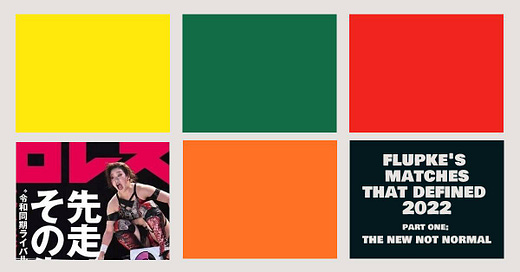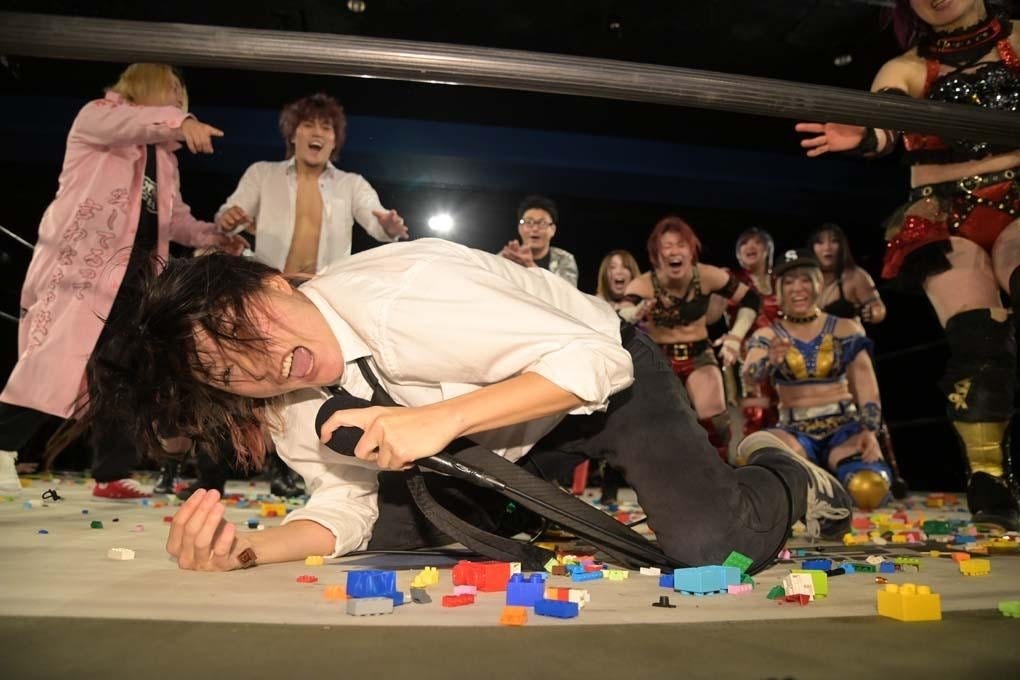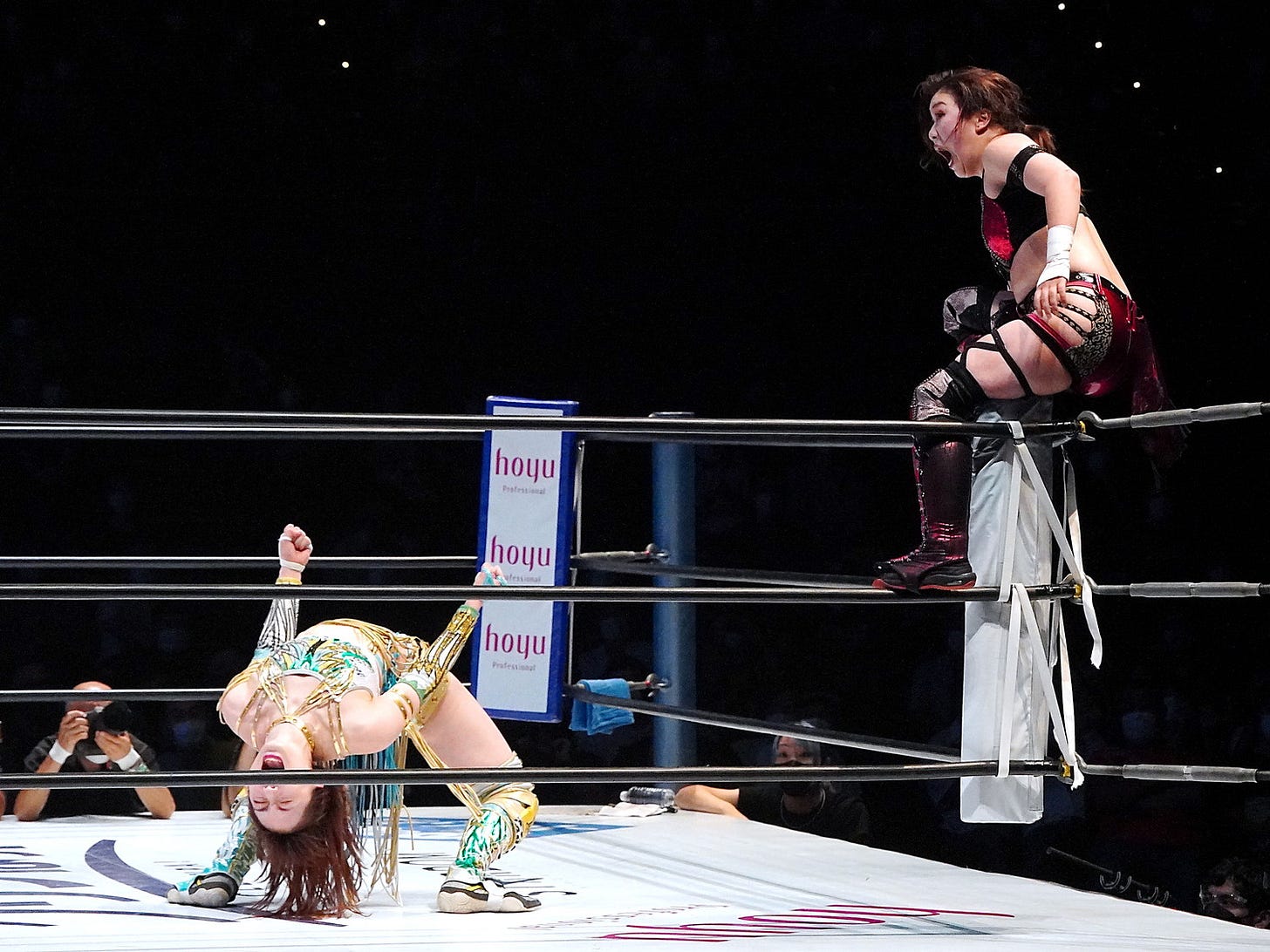Front Matter
A note for readers: this is the first of five end-of-year posts that, for a whole host of reasons, shouldn’t be treated as a conventional “Match of the Year” list. Over the course of this week I’ll be diving into ten matches which best illustrated the key trends in wrestling as I experienced it in 2022. We’re not necessarily talking five star classics here, although the series will conclude with a match that I consider to be the out-and-out best thing pulled off in a wrestling ring all year. We’ll also be hearing from other joshi fans for whom these matches rank highly on their own personal end-of-year lists, because individual subjective judgements aren’t everything, and I’m not alone in singling out these matches and these moments, and just because we’re a small community doesn’t mean we can’t share some kind of meaningful critical consensus. Thanks, and enjoy!
Each image used in this newsletter is linked to the Twitter account responsible for it: simply click through to bring up the original post. If you are a photographer whose image I have used here, and you do not grant me permission to reproduce your work, please let me know (Twitter: @FlupkeDiFlupke) and I will remove it. Thanks!
写真家さん、ここにイメージが写すことが許可しなければ聞いて下さって私は大至急除きます (ツイターの @flupkediflupke です)。ありがとうございます!
Subscribe for free to receive Flupke’s Month in Wrestling every month in your inbox, or donate $5 a month to access the full archive. A portion of every subscription supports Amazon Frontlines, an organisation dedicated to working with Indigenous peoples to defend their way of life, the Amazon rainforest, and our climate future.
Prominence (Risa Sera, Suzu Suzuki, Akane Fujita, Mochi Natsumi & Sanshiro Takagi) vs. Gake no Fuchi (Miyako Matsumoto, Chris Brookes, Shunma Katsumata & Senosister Mao Inoue)
04.01 / Gake No Fuchi Joshi Pro Wrestling - Clockwork Gake No Fuchi 2022 ~ Gake No Fuchi vs. Prominence ~ / Shinjuku FACE
Suzu Suzuki vs. Saya Kamitani
11.09 / STARDOM 5STAR Grand Prix 2022 (Day 13) / Yokohama Budokan
You remember those puzzles you’d get in party bags or Christmas crackers, where there’s a load of plastic squares sat in a frame, and one of the squares is missing so that you can slide them about, and you have to reconstruct a picture by sliding them into the right place, in the right order? Joshi wrestling in 2022 felt a bit like doing one of those puzzles, in reverse. Right up until the moment late last year where seven key members of the Ice Ribbon roster left the company in one clean sweep, the world-picture of joshi wrestling seemed fairly clear and settled. STARDOM were over here, hoovering up promising talent from other promotions and locking them down to exclusive contracts. Ice Ribbon were over there, one of the leading lights of the “indie” alternative to Bushiroad’s (and to a lesser extent, Cyber Agent’s) mainstream.
Then - Prominence, Colors, NOMADS, the New Blood shows. Ice Ribbon lost Tsukushi Haruka and Tsukasa Fujimoto, and looked set to rebuild around the young fab four of Yuuki Mashiro, Asashi, Kaho Matsushita and Ibuki Hoshi, only for Mashiro to announce her retirement too. Marvelous debuted a colour-themed units concept, and then abandoned it. ActWres girl’Z went through some kind of arcane chrysalis period and emerged on the other side with a twenty-strong roster of promising rookies and old hands, and Fuka as head trainer. Jungle Kyona wrestled Maya Yukihi in North Carolina. The picture I once recognised has been scrambled and reset on a seemingly monthly basis, and I’ve given up on the very notion of staying ahead of the curve.
But I did at least have a polestar to guide me through all this, because one of my favourite wrestlers of the past few years was right in the middle of it. Suzu was one of those seven wrestlers that left Ice Ribbon at the end of 2021, and the hardcore contest against Chris Brookes that opened Gake no Fuchi’s first (and only) show of 2022 was her first match under the banner of the upstart joshi deathmatch promotion she helped to found. Given all the moving parts I’ve alluded to above, it’s tricky on rewatch to recapture the levels of excitement I felt at simply hearing Suzu’s theme being played on Wrestle Universe; the fact that she was facing the man responsible for some of the most galaxy-brained wrestling I’ve seen in person made this moment all the sweeter. Twelve months on, Suzu has won Catch the WAVE and very nearly made it through to the final of the 5 Star Grand Prix, and this bizarro world snapshot now seems like one of the least unlikely things that’s happened this year.
But man, it felt incredible at the time. There were very few shows this year that felt so alive with possibility as this one did by the time SenoSister Mao was bringing down the curtain with a deranged idol performance. We’d just seen Suzu and her trailblazing deathmatch sisters put on a bold, brilliant celebration of weirdo fringe wrestling with some of the most beloved eccentrics in the Cyberfight universe. MAO and Mochi had traded invisible strong-style Mongolian Chops. Sera had beaten Miyako 105-0 under Gake no Fuchi rules. Suzu had stapled Brookes’ arse, and Spider German Suplexed him through a wooden board studded with tiny bells, and Brookes had Praying Mantis Bombed Suzu through the lid of a powder-filled coffin. Munenori Sawa sang torch songs and took bumps in a cocktail dress. This main event didn’t add anything new to the mix but perfectly reprised the spirit of the whole show - Miyako splashed Sera through a table on the outside, Akane and Shunma fought with lego swords, SenoSister Mao took ten people out with a flying cross-body. After the match, Takagi seemed to make moves to sign Prominence to the Cyberfight family, and Miyako vowed to take Gake no Fuchi to Sumo Hall. It was a glorious moment.
Most of my favorite wrestling matches are, fundamentally, quite stupid. “Gake no Fuchi vs Prominence Competitive Battle” is an exemplar of the stupid wrestling genre. This match has some of the most idiotic and pointless bumps I have ever seen, and every aspect of the performance seems designed to amuse and delight the performers (the audience’s entertainment seems like a nice, but unintended side-effect).
There’s a bit of everything here: Mongolian chops via psychokinesis, Shunma Katsumata and Akane Fujita doing self-administered back bumps into legos, Miyacoco sliding down stairs in a large tupperware. “Gake no Fuchi vs Prominence Competitive Battle” demonstrates a childlike spirit: a sense of fun and curiosity paired with an unquenchable thirst for blood. This match’s historic significance lies in introducing new viewers to Prominence in the best possible way, highlighting each roster member’s character throughout the match, but that’s not why it’s on my list. My match of the year list isn’t about anything that can be measured, it is a record of my own capacity for human emotion. Gake no Fuchi wound up on my “match of the year list” the same way any match does: I watched it, and I felt something.
- Willard (@lavenderwhiff)
Fast forward twelve weeks, and instead of spearheading some rag-tag shindie renaissance, Suzu and Sera were wrestling Donna del Mondo at Ryogoku Kokugikan itself. Suzu has featured in twice as many matches for STARDOM this year as she has for her home promotion - the only company she’s worked for more regularly is the one whose top title she briefly held, WAVE. And maybe the most surprising thing about all of this, for me at any rate, is that I don’t hate it. The first New Blood event in March marked a turning point for a market leader whose business model had up til that point looked pretty predatory. Maria, Ai Hozan, Tomoka Inaba, Aoi, Nanami and Haruka Umesaki were all there, with no immediate sense (never say never) that they were about to abandon Marvelous, JTO or Diana.
The difference between a market leader with the money to sign whatever prospects it wants and a market leader with the wherewithal to bring in outside talent for fresh match-ups and gripping invasion angles is a fairly subtle one. STARDOM still benefit financially from work being done across the scene, and you still don’t doubt their ability to lock down whoever they want, whenever they want. But suddenly that seemed to be less of a priority, and the individuals in charge of creative direction seemed happy to frame their own shows as taking place in a vibrant wider world of joshi wrestling. Suzu’s involvement was probably the one single thing that made it impossible for me to ignore STARDOM any longer, but if it hadn’t have been for this shift in philosophy it would have been a reluctant enjoyment that I got from these shows. Instead, I’m sat here now writing about a Saya Kamitani match as one of my Matches Of The Year.
Suzu Suzuki vs Saya Kamitani was an exciting match which showcased the strengths of two wrestlers who were both named in ShuPro’s 2020 Wrestlers to Watch list. Despite being complete polar opposites stylistically, they both possess an incredibly scrappy and dangerous nature which is highlighted throughout this match. Saya’s high-risk high-reward offense, which always feels like it is being improvised on the fly, was met with the strong strikes and impactful moves of Suzu, which are rooted in her strong fundamentals. While Saya did make a couple of missteps due to her reckless arsenal, both were able to overcome any negatives by turning these into an integral part of the match’s overall story. This is by no means a perfect match, but it offers a bright view of the future of two wrestlers who are being primed as the foundation of the next generation of joshi puroresu.
- Sprite (@CanofSpriteMan)
I loved this match so much. It’s almost as zany as the Gake no Fuchi stuff, in its own way. Rewatching it confirmed what it is that I enjoy so much about Kamitani, compared to more lauded Bushiroad stars like Syuri and Utami Hayashishita. She can do a Phoenix Splash, but there’s moments where she comes across more like Lulu Pencil than Kota Ibushi. The story of this match is the story of a Saya botch. She slips on the top rope attempting a swandive cross-body (or dropkick?) to the outside early on, and she hands Suzu an advantage which Suzu manages never to relinquish for the remainder of the match. At one point, watching Saya grimacing and sucking air and trying to get back to her feet, I was reminded of Pumi’s immortal commentary line: “Everything is difficult for Saya Kamitani. I don’t know why.”
What stood out on first and second viewing was just what a brilliant performance Saya then puts in fighting back from underneath, scrambling to regain face. What stands out on third viewing is just how loopy the opening five-or-so minutes are, with Suzu immediately taking the fight to the outside, and successive huge moves from the apron to the floor following Saya’s big slip. It’s two young wrestlers in all-out attack mode, using career-threatening offence as their basic currency. It’s madness, and it never stops being madness, but there’s a real method to it too, because that early unforced error gives you something to grab hold of, grounding you in the reality of the match, and even as Suzu continues to take damage down the final stretch, there’s never any doubt that her stamina bar is draining slower than Saya’s.
There’s a moment where Saya bridges up to deny Suzu an attempt at a top rope move and Suzu reacts in horror and amazement that’s so perfectly, cartoonishly overblown that a photo of it made the cover of that week’s ShuPro magazine. There’s a spinning heel kick that Saya hits which Suzu sells by doing a cartwheel and landing on her head. The Tequila Shot that Suzu hits in this match went viral (cue dozens of diligent joshi nerds making sure Tequila Saya gets her due), and when Suzu wins, she does so by hitting two back-to-back German Suplexes, which was a huge gesture the first time she did it in the summer of 2020. This is a dazzling, maximalist performance, crammed into the tidy, zippy frame of a 15-minute tournament match. It’s absolutely fitting of the stage Suzu now finds herself on, which is by no means the stage I expected to find her on this year, but which already feels like a more interesting and more varied promotion off the back of her presence there.
Tomorrow: how Rakuism revitalised the Tokyo Joshi undercard







